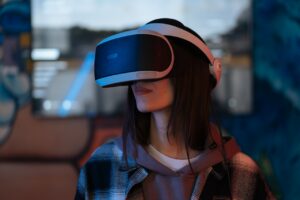One of the main vehicles for delivering augmented reality experiences has been mobile devices. Most consumers have some kind of mobile device, and AR headsets haven’t gone mainstream for consumer use just yet. Because of that, businesses have found a number of opportunities to leverage mobile devices for AR. The technology has improved significantly as well over the years.
Geospatial API for ARCore
In 2022, Google introduced a new API for geospatial experiences. This allows developers to create experiences that are tied to specific locations in space. In the past, AR experiences have been purely relative to the user or in arbitrary locations set by the user.
Geospatial API allows developers to set latitude and longitude coordinates for AR content. Scanning the physical space isn’t necessary either. It works very similarly to Apple ARKit Location Anchors, comparing images of the surrounding area to Google Street View images to determine a specific location nearly instantaneously.
ARKit 6 Enhancements
Several new features were introduced by Apple for their ARKit 6 upgrade in 2022 at WWDC. One of them is a 4K video recording while ARKit content is in use. The depth API has also received an upgrade to make scene occlusion and other experiences much more realistic. Apple’s LiDAR scanner allows AR experiences to be prepared so quickly that they call the technology ‘instant AR’.
Apple also improves its motion capture feature. When the camera is focused on another person, motion capture data can be taken from their movements and applied to a 3D model. One of the other latest upgrades is people occlusion, which allows virtual objects to pass in front of and behind people in the scene.
One major example of these ARKit 6 enhancements in use is through RoomPlan, a solution that leverages LiDAR scanning to quickly create floor plans of a house or other structure.
ARCore vs ARKit
The competition between Apple and Google in the augmented reality arena has been more or less the same over the past several years. As usual, both technologies are on par with one another in terms of software.
However, hardware is where things get more interesting. Apple’s LiDAR scanner and similar technologies found on higher-end Samsung devices can leverage the highest quality AR experiences available. However, there’s a wide variety of hardware differences between Android devices. Many Android devices simply aren’t powerful enough to handle higher-end AR.
Because of this, businesses need to be strategic about the kinds of AR experiences they want to offer. If they want to offer high-quality experiences to a smaller, wealthier audience with the devices that can handle it, they can let their imaginations run wild. However, if a business is looking for an accessible experience for more devices, they will need to tone things down a bit with a simpler app.


Average Rating